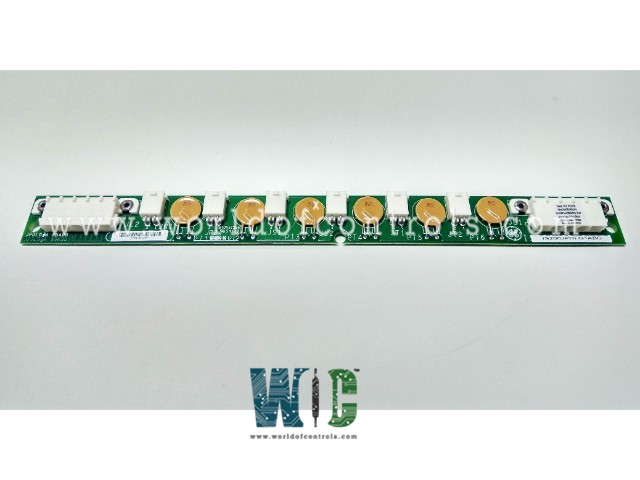SPECIFICATIONS
Part No.: IS200JPDLG1AAB
Manufacturer: General Electric
Country of Manufacture: United States of America (USA)
Input filter: Hardware filter, 4 ms
Power consumption: 20.6 watts
Temperature rating: 0 to 60 oC
Size: 33.02 cm high x 10.16 cm wide
Temperature Operating: -30 to 65 o C
Product Type: Power Distribution Module
Availability: In Stock
Series: Mark VIe
Functional Description
IS200JPDLG1AAB is a Power Distribution Module developed by GE. It is a part of Mark VIe series. The Local Pack DC Power Distribution board is a component in the management of DC power distribution within control systems. It serves as a bridge between the source of control power, such as a JPDP or JPDS, and multiple I/O (Input/Output) packs. This connection ensures that each I/O pack receives the necessary power to function efficiently.
Features
- The board is engineered to facilitate daisy-chain connections, allowing multiple downstream boards to be linked together in a series. This configuration is particularly advantageous in complex control systems, where multiple boards are required to distribute power across various components.
- To ensure safety and reliability, the board incorporates branch circuit protection for each I/O pack connection. This protection is achieved using positive temperature coefficient (PTC) fuse devices, which are designed to limit the current flow in the event of an overcurrent situation, thereby preventing damage to the connected I/O packs and ensuring the overall integrity of the system.
- One of the key design features of the board is its ability to support up to three isolated control power distribution circuits. This capability is especially important in systems that require high levels of redundancy, such as Triple Modular redundant (TMR) systems. In a TMR configuration, it is common to have separate control power sources for the R (Redundant), S (Secondary), and T (Tertiary) hardware modules. The board's design accommodates these separate power circuits on a single board, enabling organized and efficient separation of control power. This organization not only simplifies maintenance and troubleshooting but also enhances the reliability and resilience of the control system.
Module Inputs
- The board is designed to receive input power typically at 28 V DC, supplied from a JPDP or JPDS. The board is capable of handling up to three redundant power feeds, ensuring a high level of reliability and system redundancy. These three power feeds are delivered through a 5-pin Mate-N-Lok input connector, which is specifically engineered to accommodate the three separate power inputs on distinct pins. These inputs are color-coded and designated as Red, Blue, and Black, corresponding to the three different power feeds.
- The JP1, JP2, and JP3 connectors on the JPDP provide these connections, ensuring that each of the three power feeds is securely connected to the JPDL board. This configuration is essential in systems that require Triple Modular Redundancy (TMR), as it allows for continuous operation even if one or two power sources fail.
- The return current for the system is shared among the three TMR power feeds. This return current is managed through the remaining two pins of the 5-pin Mate-N-Lok connector, effectively completing the circuit and ensuring that the power distribution remains balanced and efficient across all three feeds.
Module Outputs
- The board is equipped with six identical output circuits, each designed to provide power to individual I/O packs. These outputs are carefully organized to maintain the redundancy of the input power feeds. Specifically, two of the output circuits are sourced from each of the three TMR power feeds—Red, Blue, and Black—corresponding to the R, S, and T feeds, respectively.
- Each of the six I/O pack feeds includes a re-setting positive temperature coefficient (PTC) fuse device. These fuse devices, labeled as CL (current limit), are integral to the branch circuit protection of the system. The CL fuse devices are designed to reset automatically after a fault condition is cleared, providing continuous protection against overcurrent situations without the need for manual intervention.
- This branch circuit protection is meticulously coordinated with the wiring between the JPDL board and the I/O packs, ensuring that the power distribution is both safe and reliable. The use of re-setting PTC fuses also enhances the durability and longevity of the system, as they help prevent damage to the I/O packs by limiting the current flow in the event of an overcurrent situation.
The WOC team is always available to help you with your Mark VIe requirements. For more information, please contact WOC.
Frequently Asked Questions
What is IS200JPDLG1AAB?
It is a Power Distribution Module developed by GE under the Mark VIe series.
How does the board support system redundancy?
The board is designed to support up to three isolated control power distribution circuits, making it ideal for systems requiring high levels of redundancy, such as Triple Modular Redundancy (TMR) systems. By organizing the power feeds into separate circuits, the board ensures that control power remains isolated and organized, which enhances system reliability.
Can the board be used in TMR systems?
Yes, the board is specifically designed to support TMR systems. It provides three separate power circuits R, S, and T feeds allowing for organized separation of control power. This feature is essential for maintaining system redundancy and reliability in TMR configurations.
What happens if one of the power feeds fails?
In the event of a failure in one of the power feeds, the board's redundant design ensures that the remaining feeds continue to supply power to the I/O packs. This redundancy is key to maintaining uninterrupted operation in critical systems.
